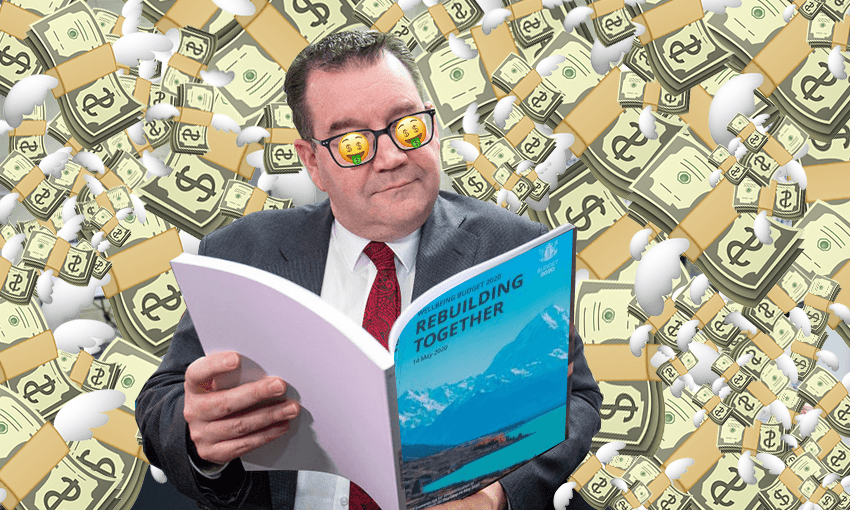Budget 2020: The centrepiece of the 2020 budget revealed today is a massive multibillion outlay for recovery from the pandemic. Here’s how it breaks down – and what the opposition makes of it.
Fifty billion sounds like a lot.
“This is the most significant financial commitment by a New Zealand government in modern history,” said Grant Robertson, minister of finance, in parliament today.
Is it just packaging? How much would have been spent anyway?
Some of it would no doubt have been spent anyway in an election year budget, but this is exceptional expenditure. And it’s not everything. There’s $3.3bn extra for education and health that isn’t part of the recovery fund, for example.
It’s called a ‘response and recovery fund’. Is this a recovery package or a stimulus package?
Both.
Is this extra to what’s already been spent on the Covid response?
Not entirely: $13.9 billion has already been spent or allocated in the weeks since the Covid crisis struck.
So that leaves another, what, $36 billion or so?
Roughly. Of that, the budget includes $15.9 billion allocated spending as part of the fund “to continue the immediate response and kickstart the economy”.
That leaves $20.2 billion to be spent along the road.
What has that $13.9 billion gone on?
The wage subsidy, the essential workers leave scheme, support packages for small and medium sized businesses, the business finance guarantee scheme, and other health spending.
Will the wage subsidy continue?
Yes. The wage subsidy was originally slated for 12 weeks, which would have seen it come to an end on June 10. It’s been extended by eight weeks to September 1. The criteria are stricter, however: the headline is that businesses need to have taken a 50%, rather than a 30% hit. The extension is estimated to come in at about $3.2 billion. More details are here.
To the $15.9 billion then. What are the big tickets?
There’s $3 billion for infrastructure projects – this is on top of the $12 billion “New Zealand Upgrade” announced at the start of the year and existing Provincial Growth Fund infrastructure outlay.
There’s $1.4 billion for trades and apprenticeships training.
$1.1 billion for an “environmental jobs package” to provide more than 10,000 “nature-based jobs” (in regional environmental projects, biosecurity, weed and pest control and DOCs Jobs for Nature Fund).
And there’s a $400 million rescue package devoted to the tourism sector.
There’s also a programme to build an extra 8,000 new public and transitional homes, funded by Kāinga Ora borrowing about $5 billion over 4-5 years, with $570m to come out of the recovery fund for income related rent subsidy.
What else?
Other spending from the fund includes:
- $216 million to “revitalise the international business sector will”.
- $56 million extra for the government’s insulation and heating programme.
- $150 million “equity injection” to NZ Post to forestall cuts to service and workforce or major price increases.
That all still leaves $20 billion burning a hole in Robertson’s pocket. What happens to that?
The finance minister said it would be “used to support New Zealanders through each stage of the impact of the virus. It is designed to not only support the immediate response but also provide support, as necessary, over the longer term to rebuild our economy and society.”
It will be assigned according to three criteria:
- Fighting the Virus and Cushioning the Blow: acting swiftly to contain the virus and avoid the extreme human and economic costs of an uncontrolled outbreak.
- Kickstarting the Recovery: continuing to support households and businesses and preparing to kickstart the economy in the medium term.
- Resetting and Rebuilding: taking the opportunity to reset our economy, address longstanding challenges and chart a course to return to a more sustainable fiscal position.
Will it all be spent?
Not necessarily. The advice is: “Ministers have been provided clear guidance that the size of the fund is not a spending target, and that they must first manage Covid-19 related expenditure within existing baselines.”
Is there any extra support for beneficiaries?
Nothing new. In mid-April the government announced a permanent $25-per-week benefit increase and doubling the winter energy payment.
What does the opposition make of it?
While the National Party welcomed the extension of the wage subsidy, “the $50 billion slush fund is totally unacceptable”, said Paul Goldsmith, finance spokesperson, in a statement. “The government has cynically set aside more than $20 billion that it can spend before the election.”

